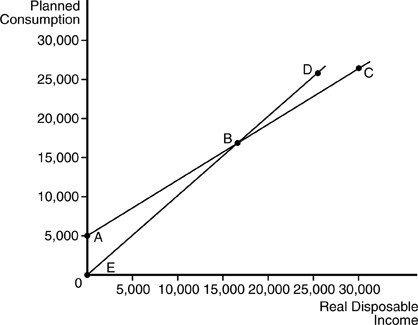If a firm stops production, then its:
A. total costs may increase or decrease.
B. variable costs drop to zero.
C. fixed costs rise.
D. All of these are true.
Answer: B
Economics
You might also like to view...
Distinguish between macroeconomics and microeconomics
What will be an ideal response?
Economics
The desired fiscal restraint is equal to
A. Excess AD times the multiplier. B. Excess AD divided by the multiplier. C. GDP gap divided by the multiplier. D. Desired AD reduction.
Economics
 Refer to the above figure. Line EBD is called
Refer to the above figure. Line EBD is called
A. the 45-degree line. B. the saving function. C. aggregate demand. D. the consumption function.
Economics
The level of output at which all economies of scale have been exhausted is known as
A) constant returns to scale. B) minimum efficient scale. C) the economically efficient output level. D) optimal economic size.
Economics